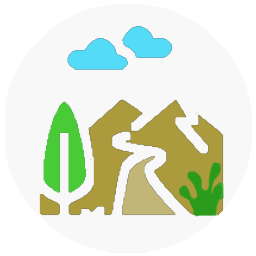Trees for Himalayan Brown Bears
Solang Valley, Himachal Pradesh, India
Available for Adoption upto: 20,000 Trees
Project Purpose
Trees for Forests™ & WildlifeLocation

In FY 2025-26, we will plant 30,000 trees in this project. It will be implemented in Solang Valley, Buruwa panchayat, Manali tehsil, Kullu district of Himachal Pradesh.

Enhancement of
Biodiversity

Carbon Sequestration

Disaster Mitigation

Promotion of
Ecotourism

Increase in
Green Cover

Reduction of
Man-Animal Conflict

Reduction in
Air Pollution

Generation of
Rural Employment

Control Soil Erosion

Improvement of
Wildlife Habitats





About Himalayan Brown Bears,
The Greater Himalayas and the alpine and sub-alpine regions of lesser Himalayas are home to a sub species of Brown bears, “Ursus arctos” commonly known as the Himalayan brown bear, marked as “Critically endangered” in the IUCN red list, (1) with only 500-700 individuals left in the wild, this large species of bear often standing 7ft tall and weighing around 500 -550 kgs is facing various climatic and anthropogenic pressures. Brown bears are one of the largest land carnivores in the world, second only to their Ursidae family relative, the polar bear. These powerful animals eat a predominantly plant-based diet of fruit, nuts, berries, leaves, and roots, which is one of the main reasons why they’re so important to the environment. As large consumers of fruits, brown bears are prolific seed dispersers, meaning that they play a vital role in plant regeneration processes. Brown bears are often thought of as dangerous creatures, but they usually avoid people and will rarely attack a human on sight. (3)

Why trees?
A 2020 Zoological Survey of India study projects a concerning 73% decline in Himalayan brown bear habitat across the western Himalayas by 2050. (2) Currently, these bears inhabit 23 Protected Areas spanning Jammu & Kashmir, Himachal Pradesh, and Uttarakhand. Climate models indicate substantial reductions in both suitable habitat and critical biological corridors, underscoring the urgent need for pre-emptive conservation planning across the Himalayan landscape to ensure species viability. (2)
This situation demands targeted ecological restoration through:
- Comprehensive baseline studies of current forest conditions
- Identification of keystone vegetation supporting bear ecology
- Strategic habitat rehabilitation using native species like oaks (Quercus spp.) and chestnuts (Castanea spp.) that serve dual purposes:
- Enhancing forest cover
- Providing natural forage resources (acorns, nuts) essential for bear nutrition
Such scientifically-grounded interventions will strengthen habitat connectivity while addressing climate adaptation needs for this vulnerable species. The restoration approach emphasizes ecologically appropriate species selection to rebuild functional ecosystems rather than simply increasing tree cover.
These interventions are necessary as there have been increasing incidents of bears foraging on human food sources particularly garbage, due to factors like habitat encroachment and human-induced food availability. (4) A comprehensive study was conducted by the Wildlife SOS team aimed to understand the diet of Himalayan brown bears through scat analysis, What came as a shock to the team was the dominant food source in the brown bears’ diet was garbage! Nearly three-fourths of all that brown bears consumed came from garbage, which means that their frequency to scavenge garbage is much higher than eating wild plant matter, crops, and even hunted sheep! (4)
The plantation location in Solang Valley happens to be one such important patch which requires ecological intervention, located in the Kullu-Manali region, the region has experienced deforestation, particularly due to the pressures of tourism and infrastructure development. The India State of Forest Report (ISFR) and other data sources indicate a loss of natural forest cover in Kullu and other parts of Himachal Pradesh. The area's vulnerability to soil erosion and landslides due to unplanned slope cutting for road construction is also a concern (5)

critically endangered Himalayan brown bear faces severe threats from habitat loss due to climate change and human activities, leading to concerning dietary shifts towards human-generated waste. To ensure the long-term survival of this vital species and the health of the Himalayan ecosystem, targeted ecological restoration efforts, focusing on native tree species that provide both habitat and food resources, are urgently required in key areas like the Solang Valley. These interventions are essential to mitigate human-wildlife conflict and promote a sustainable future for the Himalayan brown bear.
Tree species:
The important tree species occurring in Kullu Forest Division are Deodar (Cedrus deodara), Kail (Pinus wallichiana), Spruce (Picea smithiana), Fir (Abies pindrow), Ban Oak (Quercus leucotrichophora), Mohru oak (Quercus dilatata), Kharshu oak (Quercus semecarpifolia), Rakhal (Taxus wallichiana). Besides a number of other trees are found in the tract. The following species will be planted in this project:
- Deodar (Cedrus deodara): Forms mixed stands with Kail providing critical canopy cover for bear movement and thermal regulation. Its seed cones support small mammals that are prey species for bears.
- Kail (Pinus wallichiana): Dominates higher elevation forests, creating essential wildlife corridors between feeding areas. The tree's resin-rich bark attracts insects that supplement bears' protein intake during active seasons.
- Spruce (Picea smithiana): Growing with Fir in subalpine zones, these trees maintain cool microclimates crucial for bear summer habitat. Fallen logs create denning sites and host grubs that bears forage.
- Ban Oak (Quercus leucotrichophora): As the primary acorn producer, this protected species provides vital autumn nutrition for bears preparing for hibernation. Its broad canopy offers shade in summer months.
- Mohru Oak (Quercus dilatata): Another key acorn source, particularly near human settlements where community protection helps reduce human-bear conflicts over food resources.
- Kharshu Oak (Quercus semecarpifolia): Growing at highest elevations, this oak maintains critical high-altitude foraging areas and connects alpine meadows with forest habitats.
- Rakhal (Taxus wallichiana): Though scarce, its dense foliage provides important cover in Fir/Spruce forests. As a protected species, its conservation helps maintain intact forest ecosystems.
These native trees collectively create:
- Year-round food sources (acorns, insects, small mammals)
- Movement corridors between elevations
- Thermal cover and denning habitat
- Healthy forest soils supporting berry-producing understory
- Natural barriers reducing human-bear encounters
Their preservation and restoration are essential for maintaining viable brown bear populations amid climate change and habitat fragmentation pressures. The mixed-age composition of these forests particularly benefits bears by providing varied food sources and shelter options across seasons.
Social Impact:
The tree plantation project in Solang Valley will actively engage local communities through awareness programs and participatory conservation efforts, fostering coexistence between residents and wildlife. By involving villagers in planting and protecting native species, the initiative will reduce human-bear conflicts—minimizing crop raids and garbage dependence—while promoting environmental stewardship. Community-led monitoring and eco-tourism opportunities will further strengthen social ownership of conservation goals.
Economic Impact:
The project will generate seasonal employment for 150+ locals during nursery development, plantation and maintenance phases, boosting rural livelihoods. Long-term economic benefits include sustainable harvesting of non-timber forest products (NTFPs) like medicinal herbs (e.g., Taxus leaves) and oak-based fodder, creating year-round income streams. Enhanced forest cover will also support eco-tourism and apiculture, diversifying revenue sources while protecting the Himalayan brown bear’s habitat.
References:
- https://www.iucnredlist.org/
- https://www.downtoearth.org.in/wildlife-biodiversity/encroachment-pushes-himalayan-brown-bears-into-kashmir-s-villages-89682
- https://www.ifaw.org/international/animals/brown-bears
- https://wildlifesos.org/food-for-thought-diet-of-himalayan-brown-bears
- https://pib.gov.in/PressReleasePage.aspx?PRID=2086742
- https://threatenedtaxa.org/index.php/JoTT/article/view/1715
- https://www.thecitizen.in/life/an-un-bearable-meal-554924
- https://www.researchgate.net/publication/270475106_Fast_food_bears_Brown_bear_diet_in_a_human-dominated_landscape_with_intensive_supplemental_feeding
- http://www.bearconservation.org.uk/himalayan-brown-bear/
- https://animalia.bio/himalayan-brown-bear?custom_list=937
- https://indianecologicalsociety.com
- https://royalsocietypublishing.org/doi/10.1098/rspb.2017.1804









